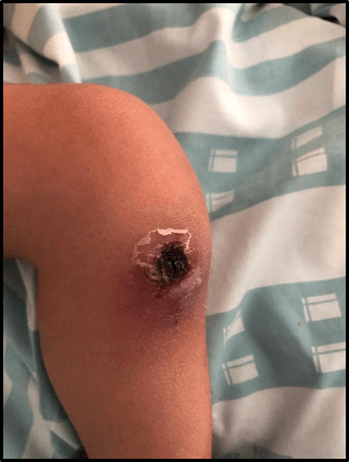Francisco Maria Fernandes Vinagre Pinhol Abrantes1, António Maria Cardoso Bastos Gama da Silva1, Ana Catarina Duarte Sequeira Bastião de Almeida2, Sofia da Costa Lima2
1Hospital de Santa Maria, CHULN, Lisbon, Portugal, 2Hospital Beatriz Angelo, Loures, Lisbon, Portugal
Address for Correspondence: Francisco Maria Fernandes Vinagre Pinhol Abrantes, Estrada da Cruz, nº19, 6ºC.
Email: franciscoabrantes@edu.ulisboa.pt
|
Question :A previously healthy 21-month-old boy presented to the Emergency Department (ER) with persistent fever lasting for 11 days, accompanied by cough and rhinorrhea. He underwent analytical evaluation, where a positive IgM for Epstein-Barr Virus (EBV) was found and the diagnosis of infectious mononucleosis was made. Total neutrophil count was of 670/ul. He was discharged and became afebrile shortly after.
The following week, he returned to the ER after re-initiating fever, along with the appearance of a small necrotic lesion on his left leg. Exudate from the lesion was collected for microbiological examination and he was admitted under intravenous amoxicillin + clavulanic acid. During the hospital stay the lesion’s dimensions increased and he developed severe neutropenia (minimum neutrophil count 70/uL). Pseudomonas aeruginosa was later isolated from the exudate, leading to the diagnosis of ecthyma gangrenosum. Antibiotic therapy was switched to piperacillin-tazobactam + amikacin, with a good clinical response. He became afebrile and the lesion resolved. Neutropenia resolved spontaneously in about 3 weeks time. He was later screened for primary immunodeficiency and no alterations were found.
Figure 1. Necrotic Skin Lesion at Admission.  What is the most likely diagnosis for this necrotic skin lesion in a neutropenic patient?
|
Discussion :
EBV infection is a known cause of transient neutropenia, thus paving the way for severe bacterial infections such as ecthyma gangrenosum. 1 Ecthyma gangrenosum is a cutaneous infection that most commonly occurs in immunocompromised patients. However, it is important to bring clinical awareness to the fact that in particular contexts this entity can also occur in immunocompetent patients. Pseudomonas aeruginosa is the most common bacteria responsible for this infection, with one study identifying p. aeruginosa in 74% of cases. 2 Treatment with broad-spectrum antibiotics such as piperacilin-tazobactam and carbapenems should be initiated shortly after obtaining blood and swab cultures. 3
This article presents a rare case of ecthyma gangrenosum in an overall immunocompetent patient, temporarily immunocompromised after an EBV infection. We hope this very graphic image, characteristic of this entity, helps clinicians to memorize and recognize it in future patients. | References : | - Larochelle B, Flamand l, Gourde P, Beauchamp D, Gosselin J. Epstein-Barr Virus Infects and Induces Apoptosis in Human Neutrophils. Blood 1998; 92 (1):291-9 (DOI: https://doi.org/10.1128%2Fjvi.74.6.2612-2619.2000).
- Vaiman M, Lazarovitch T, Heller L, Lotan G. Ecthyma gangrenosum and ecthyma-like lesions: review article. Eur J Clin Microbiol Infect Dis. 2015; 34(4):633-9 (DOI: https://doi.org/10.1007/s10096-014-2277-6).
- Bassetti M, Vena A, Croxatto A, Righi E, Guery B. How to manage Pseudomonas aeruginosa infections. Drugs Context. 2018; 7:212527 (DOI: https://doi.org/10.7573/dic.212527).
|
|
| Correct Answers : |  100% 100% |
Last Shown : Aug 2025
|